6.2 Maintaining direction
Sea kayaks can behave like they have a mind of their own in wind and waves. Holding a straight course can be challenging. As with any skill, maintaining direction needs practice, but I think it’s very helpful to understand a bit of the theory of what’s going on. The explanations below focus on the effect of wind on the boat, but waves, especially short chop, can have similar effects.
6.2.1 The problem
Let’s start by thinking about a kayak sitting sideways-on to the wind:
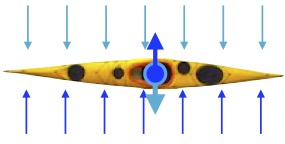
The kayak is subject to forces from the wind and from the water:
The wind force acts all along the side of the boat (light blue arrows). In most sea kayaks, the side area exposed to the wind is fairly balanced front to back. The net effect is as if all the wind force were acting at a ‘center of pressure’ (light blue dot and thick arrow) around the middle of the boat
As the boat starts to move sideways across the water, the hull of the kayak will experience water resistance (dark blue arrows). Like the wind force, this acts all along the boat. Again, most kayaks are fairly balanced front to back and the center of pressure of the water resistance (dark blue dot and thick arrow) is around the middle of the boat.
So, the forces of wind and water act in about the same place, and the boat will tend to stay sideways on to the wind. If we shift the wind force forwards (e.g. by placing a large object or sail on the front deck), the boat will tend to rotate anticlockwise:
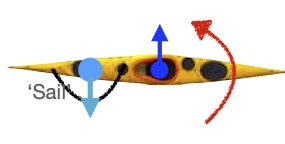
Similarly, if we change the shape of the hull, the water’s resistance can change. One way to do this is to put the boats’s skeg down (more on skegs below…):
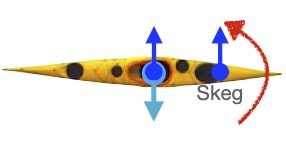
The additional water resistance of the skeg is shown as a second blue dot. The skeg locks the back end of the boat in the water, and the boat rotates anticlockwise due to the wind.
We’ve not actually tried to paddle anywhere yet, but hopefully the physics is starting to make sense!
When we do start paddling, the wake at the front of the boat and the disturbed water at the back tends to shift the centre of water resistance of the boat forwards. It’s as if the boat’s bow becomes ‘locked’ in the wake, whilst the stern is free to move. If we’ve paddling into wind, this isn’t a problem:
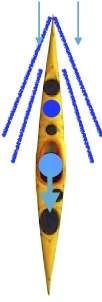
Notice that the boat’s ‘locked’ at the centre of water resistance (dark blue dot), with the centre of wind pressure (likely mostly due to the paddler’s body) behind it. Like a pendulum hanging vertically, having the wind force acting behind the water resistance is a stable configuration. Whilst it’s hard work to paddle upwind (you’re fighting both the water resistance and the wind), the boat will tend to go in a straight line.
What if we want to paddle downwind?
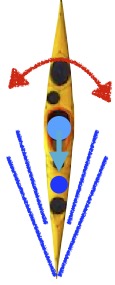
Everything is similar, except the wind force is now acting behind the water resistance force. It’s like we’ve turned the pendulum upside-down. If we can keep the boat perfectly aligned, things might be OK, but any deviation from straight will tend to make the boat swing, with the stern moving away from the wind.
Paddling across the wind is even worse:
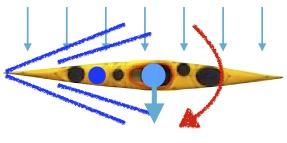
Now the wind force and the water resistance act at different places along the boat. The boat will tend to turn upwind. We refer to this as ‘weathercocking’.
In summary, a kayak being paddled forward in wind will tend to turn towards the wind (weathercock), because the wind force acts further back on the boat than the water resistance force.
How do we deal with this?
6.2.2 Using the paddle
A simple approach is to shift your hands along the paddle shaft such that you have a longer lever on the upwind side of the boat and a shorter lever on the downwind side. Doing this puts more power into the upwind strokes, tending to counteract the turning effect.
Needless to say, this isn’t very efficient!
6.2.3 Using edge
We’ve learned that sea kayaks edged to the right tend to turn left, and vice versa (see notes on “Demonstrate effective and efficient turning of a sea kayak”. If we edge towards the wind, the turning effect of the edge counteracts the weathercocking tendency, and, with practice, we can get the boat to go where we want it to.
This actually works quite well for short distances. Over long distances, holding an edge can be quite tiring. In high winds, a lot of edge is required, which can feel quite unsteady.
6.2.4 Using the skeg
We discussed earlier how the skeg alters the water resistance on the boat hull. Given that our problems are caused by the water resistance acting too far forwards, it’s logical to use the skeg to bring the resistance towards the stern of the boat.
This is easy if we’re going downwind - putting the skeg all the way down helps the boat to track:
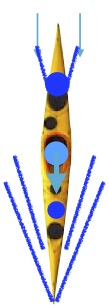
The extra lateral resistance of the skeg (big blue dot) now tends to pin the stern in place. The wind acts further forward on the boat, and everything acts in a nice stable line.
Going across the wind, things are a little more complicated:
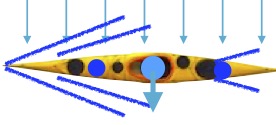
We now have the lateral resistance of the skeg and boat acting sideways against the wind resistance. It’s like a see-saw with the wind acting as the pivot in the middle and the boat and skeg resistances on either end. If we can balance everything out but putting the skeg down just enough, we’ll go in a straight line. This takes practice, but once you’ve got it adjusted right, the boat should track well across wind.
Here’s a video covering the same points. Note that rudders are more common on sea kayaks in the US, whilst UK paddlers have traditionally tended to use skegs: